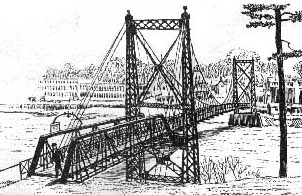 |
Kotlas - Waterville Area Sister City Connection P.O. Box 1747 Waterville, ME 04903-1747 Write to Us |
 |
 |
Kotlas - Waterville Area Sister City Connection P.O. Box 1747 Waterville, ME 04903-1747 Write to Us |
 |
|
Home > Projects > Our Rivers > Halfway Halfway through the Rivers ProjectSince last September, twelve students from four area high schools have been studying the ecology of the Kennebec River and its tributaries. They are preparing for twin exchanges in February and April with Kotlas students studying their city's river, the Northern Dvina. The class comprises Brad Martin, Mike Veilleux, Ali George, and Crystal Dostie of Messalonskee High School in Oakland; Cheri Young, Sarah Johnson, and Jessica Deane of Winslow High School; Matt Reid, Burt Helm, and Kevin Paul of Waterville High School; and Melissa Clark and Andrew Beane of Lawrence High School in Fairfield. Their instructor is Mike Waters, a science teacher at Messalonskee. The students meet officially once or twice a month for most of the school day. They will have had eleven daylong classes by the end of the project in May. They have also spent over 30 hours together outside class on related studies. During the fall, they studied the river's ecology and chemistry. For example, in September they placed nine multiplate collectors in the Kennebec and its tributaries. These 3"-cubes consist of a series of parallel plates that are about 1/8" apart and are connected by a central bolt. The collectors were colonized first by algae, then by various species of river bugs. After four weeks, the students retrieved the collectors. By examining the number and diversity of organisms in the collectors, they could gauge the health of the river. The students also measured the flow, acidity, temperature, concentration of dissolved oxygen, and other river characteristics at each site. Dave Courtemanch of Maine's Department of Environmental Protection helped them analyze the results. Other outside experts have also aided the students in their research. They include Profs. Frank Fekete, David Firmage, and Whitney King, of the biology and chemistry departments at Colby College; and Paul Nielsen, an amateur ornithologist, who helped them conduct a waterfowl survey in December. To prepare for the actual exchange visits, the students are studying Russian language and culture. Each student has read and written a book report on a different Russian novel and together the class is reading two Russian short stories. The Waterville and Lawrence students are taking Russian lessons from Prof. Sheila McCarthy of Colby and the Winslow and Messalonskee students are taking an adult education language class from Martha Thornton of Hallowell. The October delegation from Kotlas also visited the class and Phil Gonyar made a presentation about Kotlas. Recently, the Waterville area students have begun e-mail correspondence with their Kotlas counterparts as well. According to Waters, his students are "eagerly anticipating" the arrival of their Russian counterparts. "They have been working hard to learn how the health of a river system can be determined and are excited to be sharing their results," he said. "The challenge of working with students of such a different cultural and linguistic background provides high incentive to the preparations. The goal for the students is to find a common ground amid these differences." When the Russian students came in February, the two groups did laboratory analyses of river water together. Then, in March, our students toured the water treatment facility and the pulp and bleaching operation at the SAPPI paper mill in Hinckley. At their last meeting, in April, they performed additional laboratory analyses. This article originally appeared in the Winter 1998-1999 issue of the Kotlas Connection's newsletter. |